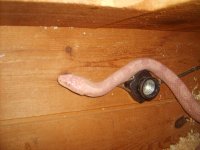newfie
New member
Hello, I have a few questions about one of the corn's we have.
We have a reddish colored corn that we think looks as close to a Cinnamon corn, however when he eats he attacks his food and spirals around it and also strikes it a lot.
We were told by a local pet store that this is the traits of a ratsnake not a corn and that it could be a hybrid of ratsnake and a corn......
First question is.....is that true?
Second.... Why is that behaviour there?
Third.....If it's a ratsnake is there any different needs then corns?
Forth...Is there a way to tell what it is for sure?
Thanks
We have a reddish colored corn that we think looks as close to a Cinnamon corn, however when he eats he attacks his food and spirals around it and also strikes it a lot.
We were told by a local pet store that this is the traits of a ratsnake not a corn and that it could be a hybrid of ratsnake and a corn......
First question is.....is that true?
Second.... Why is that behaviour there?
Third.....If it's a ratsnake is there any different needs then corns?
Forth...Is there a way to tell what it is for sure?
Thanks

